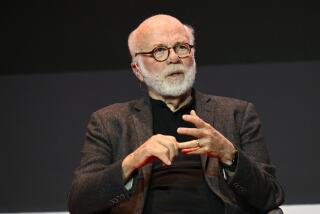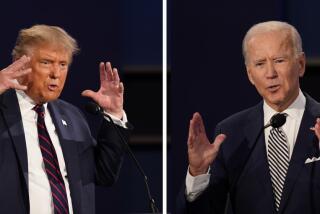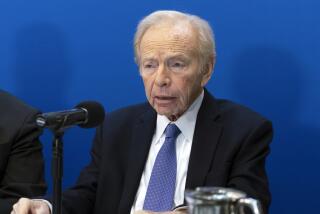Ranking the veeps
Today’s question: Give us your list of best and worst vice presidents in recent history. Previously, Lichtman and Edwards debated the proper role of the vice president, discussed how history might treat Dick Cheney and digested the current candidates’ running-mate choices.
Cheney: in the company of Spiro Agnew and Aaron Burr
Point: Allan J. Lichtman
Any attempt to pick the worst and best vice presidents in U.S. history depends heavily on your values and beliefs. So you might expect, Lee, that we’ll make some different choices -- or perhaps after this week of constructive exchanges we’ve gained greater appreciation for each other’s points of view.
I’ll start with my list of the worst.
Spiro T. Agnew, Richard Nixon’s vice president, poisoned the politics of the late 1960s and 1970s with his vitriolic attacks on Democrats and liberals. He was a petty crook who pocketed bribes and kickbacks while he was governor of Maryland and perhaps as vice president as well. He resigned the vice presidency in disgrace after pleading no contest to a single count of income-tax evasion.
Aaron Burr was estranged from President Thomas Jefferson throughout his four years as vice president. He killed Alexander Hamilton in a duel and engaged in a land-grab scheme that resulted in his indictment for treason.
Dick Cheney has exceeded the authority of his office, contributed to secrecy in government, engaged in political vendettas and taken the lead in advancing unwise policies on the environment, energy, foreign affairs, budgets and taxes.
Thomas R. Marshall was a distinguished and experienced politician who did absolutely nothing in eight years as Woodrow Wilson’s vice president. He is remembered today only for saying, “What this country really needs is a good five-cent cigar.”
John Nance Garner was one of America’s best and worst vice presidents. During Franklin Roosevelt’s first term, he helped sell the New Deal in Congress. But during the second term, he sabotaged FDR’s policies and in 1940 became the only vice president to challenge the sitting president for the party’s nomination.
Here’s my list of the best:
Garret Hobart, William McKinley’s vice president, built his career primarily as a seasoned political operative rather than an elected official. McKinley trusted the judgment of his vice president and Hobart served as a presidential confidant until he died in office in 1899.
Richard Nixon, who served under President Dwight Eisenhower in the 1950s, was the first vice president to emerge as a key administration spokesperson, party liaison and campaigner. He was the administration’s most prominent ambassador to the world.
Walter Mondale advanced the substantive importance of the modern vice presidency by serving as an indispensable advisor to President Jimmy Carter.
Al Gore continued in the tradition of Mondale. He provided importance policy advice to President Bill Clinton during his eight years in office. Like Mondale, however, Gore proved to be a better vice president than presidential candidate.
Lee, I’ve enjoyed our exchanges this week and I hope we’ve given our readers plenty to think about.
Allan J. Lichtman is a history professor at American University in Washington. His most recent books are “The Keys to the White House” and “White Protestant Nation: The Rise of the American Conservative Movement.”
All honorable men (well, almost)
Counterpoint: Lee Edwards
Well, Allan, I won my bet with myself: I predicted that you would pick Cheney as one of the worst vice presidents in history. Never mind that the only thing Cheney is guilty of is fulfilling his constitutional oath to “provide for the common defense” against all enemies, foreign and domestic -- especially Islamic terrorists.
But I agree with your placing Agnew at the top of the “worst” list. By covering up his acceptance of regular cash payments from Maryland contractors and lying to the American people about his malfeasance, Agnew violated the law and the Constitution.
As for my list of the best and worst vice presidents, I decline to offer one. It smacks of the “gotcha” philosophy that taints so much of our journalism and our political debate these days. I think that every vice president in the modern era (with the exception of the aforementioned Agnew) was a dedicated public servant doing what his president asked him to do. Some were better than others.
George H.W. Bush, Gore and Nixon, all of whom were given extensive responsibilities, are regarded by most historians as having been excellent vice presidents. Hubert Humphrey, Johnson and Mondale were given more limited duties, which makes a definitive judgment about their service problematic. But they were all honorable men.
The vice presidency is a quintessentially American institution that is broadly defined and allows its occupant to make the most of it under the direction of the president. Politicians certainly understand its importance. As the political scientist James Q. Wilson wrote, for all the good and bad jokes about the vice presidency, candidates still struggle mightily for it.
So Garner was wrong -- the office is worth far more than a pitcher of warm “spit.” Jefferson, who held both offices, offered this telling observation: “The second office of the government is honorable and easy, the first is but a splendid misery.” What has changed since Jefferson’s time is that “second office” is no longer easy.
Allan, I too have enjoyed our debate. Forgive the mixed metaphor, but I think our daily Dust-Ups provided plenty of light as well as heat.
Lee Edwards is the Distinguished Fellow in Conservative Thought at the Heritage Foundation and the author of nearly 20 books, including a forthcoming biography of William F. Buckley Jr.
| | | Day 4
More to Read
A cure for the common opinion
Get thought-provoking perspectives with our weekly newsletter.
You may occasionally receive promotional content from the Los Angeles Times.






